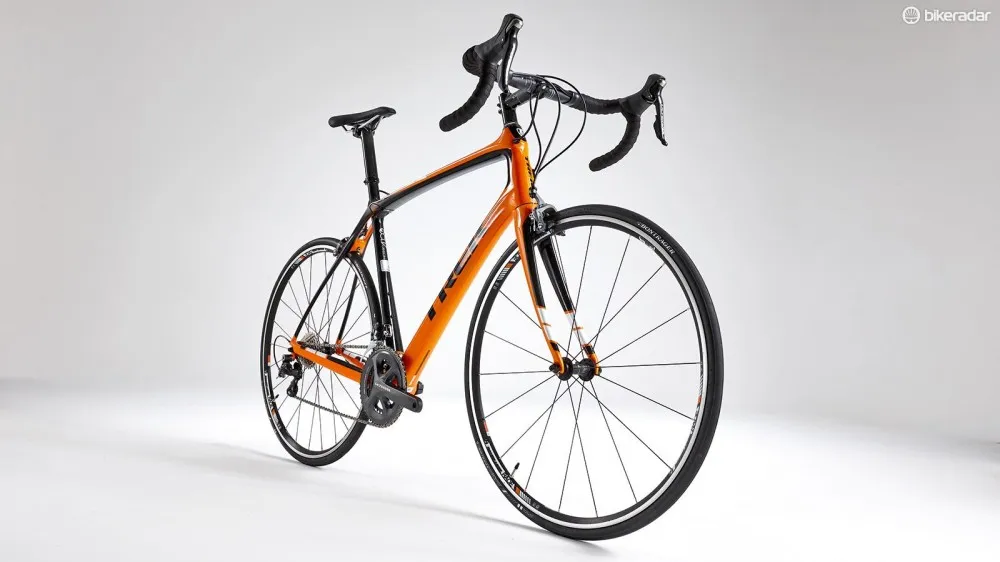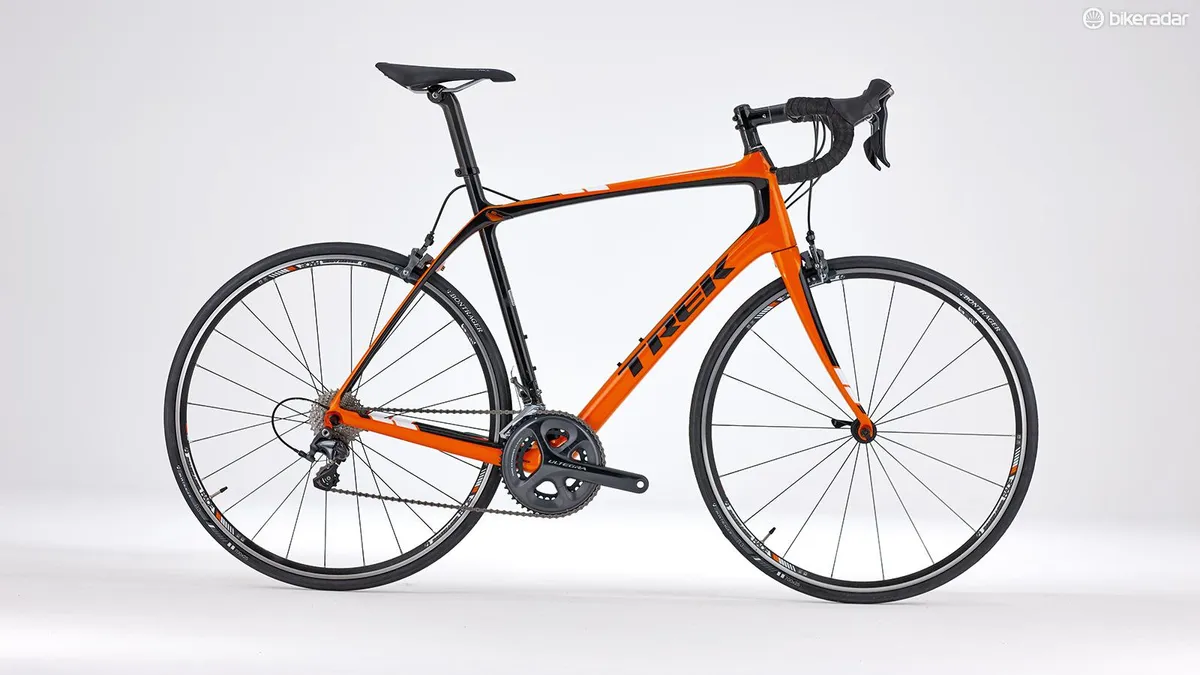Ever since its introduction, we've found Trek’s unique Domane to be one of the best-ever rides for bad surfaces. That’s all thanks to the ‘Isospeed’ decoupler, which is essentially a rotational pivot that attaches, via lugs, the seat tube to the top tube.
Because the seat and top tubes aren't connected in the conventional way, the seat tube can bow and flex along its full length (and there is a nifty carbon composite layup under the paint to aid that). The really clever part is that unlike a true suspension system it's no more affected by pedalling than a carbon seatpost, but the increase in length available to flex offers multiple times more shock absorption than a standard bike.
- Highs: Sublimely smooth chassis, and loads of fun to ride
- Lows: Like plenty of its rivals the 5.2 deserves better wheels
- Buy if: You want a truly comfortable speed machine that’s unfazed by bad roads
Video: trek domane 5.2
When you get onboard a Domane you're likely to spend a few minutes trying to identify the rear end's movement. On decent roads you’ll be hard pushed to detect any real difference, but get onto coarser surfaces and you’ll notice it immediately. Thankfully though you don’t feel isolated from reading road texture, which is always handy when trying to judge grip levels for cornering speed. The back end does a wonderful job of nulling any fatigue-building buzz and the clever front fork with its offset dropout design also adds a little length to the fork. By increasing the path on which vibrations travel, by the time they hit you they're minimised.

Trek’s Isospeed ‘pivot’ lets the seat tube flex for rear end plushness
All of this might sound like the Domane is just a big plush cushion of a bike to ride, but in fact almost the opposite is true. It may well be smooth but it's also stiff, thanks to the massive BB90 bottom bracket shell and asymmetric oversized chainstays. The H2 geometry (in Trek terms that’s midway between an out-and-out race bike and a more upright, short reach endurance style) strikes a highly appealing middle ground, enabling both a good low, fast position in the drops and a comfortable, not-too-stretched and not-too-short stance on the hoods.
The other upside of the active rear end is also a dynamic one. Throw the Domane hard into a corner, especially one with a poor surface, and the tyres seem to bite harder while the frame absorbs any bounce. It’s a remarkable feel – and once you’re attuned to the Domane's potential it's seriously rapid too.
At just over seven and a half kilos the Domane is no heavyweight, and that’s with middleweight running gear. Fine all-rounder gearing combining compact chainrings and an 11-28 cassette means the Trek is perfectly considered for climbing. The tenacious way the rear end grips and the smoothness of the ride makes it as competent uphill as it is thrilling on the way back down.
In the past what’s held Trek back from reaching the top step of the podium is its spec sheet, with corners being been cut to meet a price point. For 2015 though, with this along with the also-superb Emonda, it looks as if those days are gone. This 5.2 comes with an omisson-free full complement of Ultegra (so no slipping in a non-Shimano chain or cheaper cassette). Elsewhere there's a full-suite of Bontrager parts – no surprise as that’s the parts supplier in the world of Trek.
It’s all very good stuff. Starting up front, the Race Lite IsoZone VR-CF bar is a real winner. The shaped alloy bar is designed for integrated IsoZone pads (made from a high density foam), which are bonded to it and sit underneath the bar tape. They extend from the hood towards the bar centre giving a very cushioned hold – great for riding over cobbles or rough gravel roads.

The Domane's H2 geometry hits the sweet spot between racing poise and comfort
The dedicated carbon seat pillar, meanwhile, is topped by Bontrager's Paradigm saddle, which is slender but extremely well padded and a great shape to boot.
In terms of rolling stock the Domane shares a wheelset with its Emonda sibling. The Race may well be the base model in Bontrager's range and at 1720g a pair they aren’t the lightest wheels around, but the shape is good – wider than traditional rims with the 17.5mm internal width – and they're tubeless ready too. They're shod with R3 hardcase tyres; the slick big-volume 25c rubber proved tough yet supple, and we were impressed with their grip on the damp roads of our test rides.
In an ideal world the brilliant chassis does deserve better hoops, and eventually that’s exactly the upgrade we'd target, but as an all-round package the off-the-shelf 5.2 can more than hold its own.



